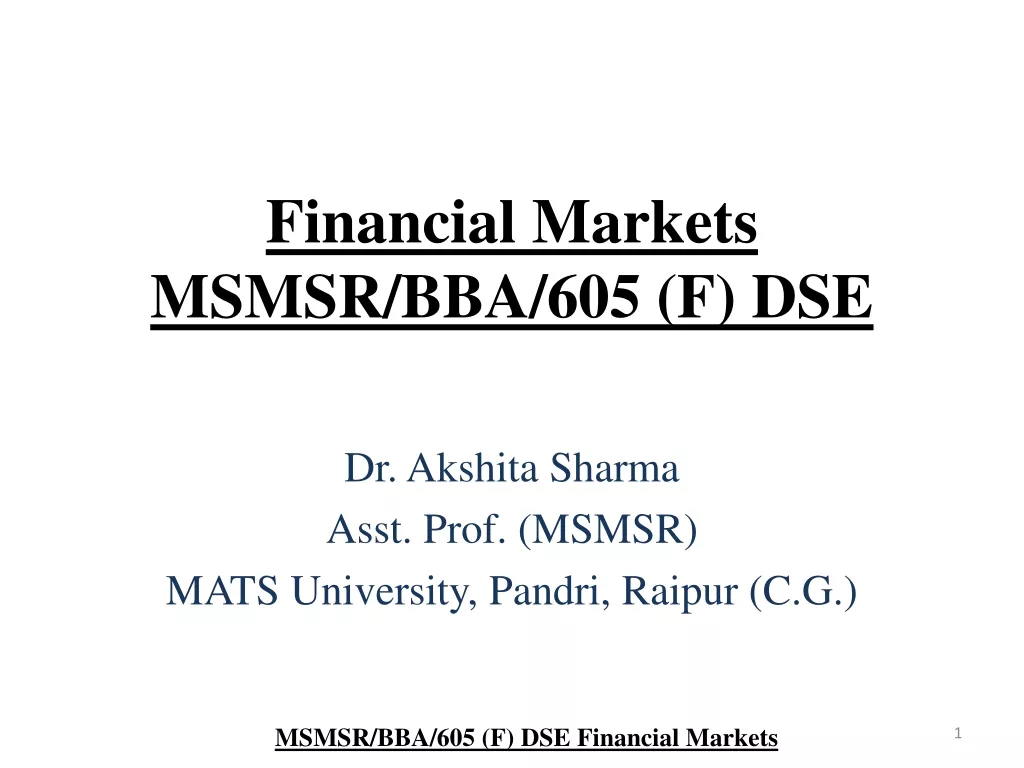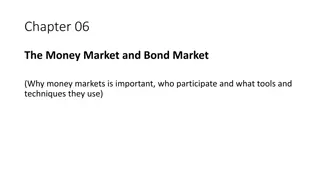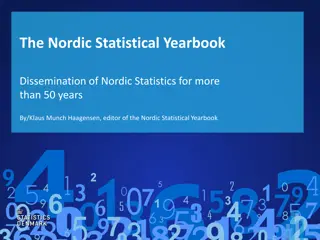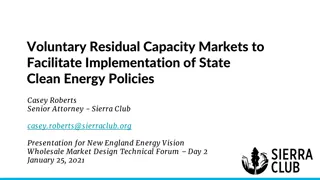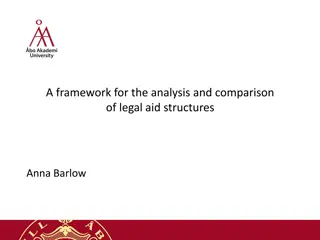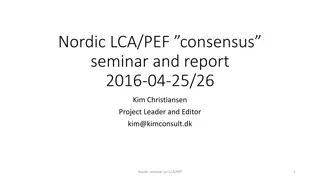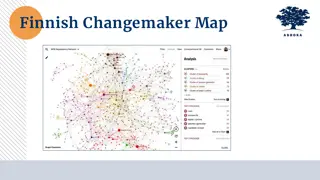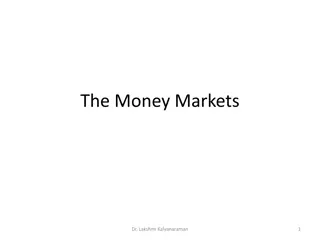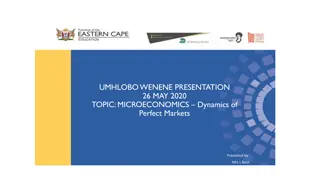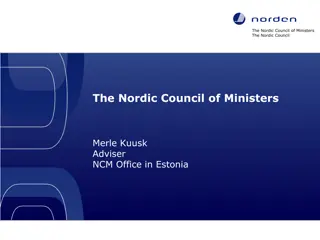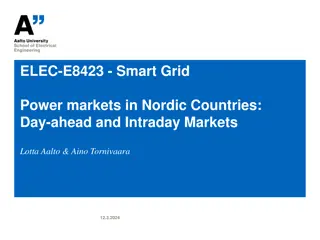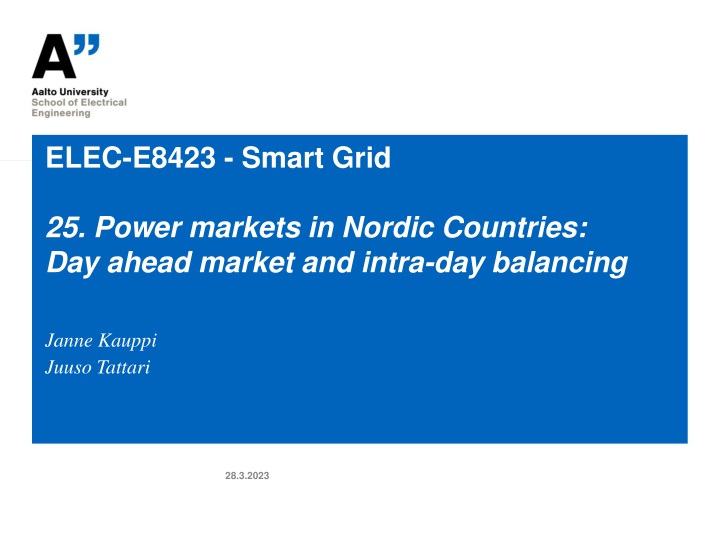
Power Markets in Nordic Countries: Day-Ahead Market Overview
Explore the dynamics of power markets in Nordic countries, focusing on the day-ahead market and intra-day balancing. Learn about market processes, pricing mechanisms, bidding zones, and the economic approach for pricing. Understand how electricity is traded and allocated efficiently in the region.
Download Presentation

Please find below an Image/Link to download the presentation.
The content on the website is provided AS IS for your information and personal use only. It may not be sold, licensed, or shared on other websites without obtaining consent from the author. If you encounter any issues during the download, it is possible that the publisher has removed the file from their server.
You are allowed to download the files provided on this website for personal or commercial use, subject to the condition that they are used lawfully. All files are the property of their respective owners.
The content on the website is provided AS IS for your information and personal use only. It may not be sold, licensed, or shared on other websites without obtaining consent from the author.
E N D
Presentation Transcript
ELEC-E8423 - Smart Grid 25. Power markets in Nordic Countries: Day ahead market and intra-day balancing Janne Kauppi Juuso Tattari 28.3.2023
Introduction Electricity can be traded in a many different market places: Time Auction for next day 10 years day- ahead Intraday Intrahour real time After delivery Financial markets Balancing markets Imbalance settlement Day-ahead Intraday Physical delivery Scope for today 28.3.2023
The day-ahead is a market where market participants sell or buy energy for the next day in a closed auction The daily process: At 11:00 EET Transmission System Operators (TSOs) publish available capacities on interconnectors and in the grid Market participants have to submit their buy/sell bids for the auction before 13:00 EET Euphemia algorithm match all the submitted bids in the pan-European market coupling process (Single Day-Ahead Coupling or SDAC) Clearing prices for each hour and each bidding zone are announced around 13:45 EET & individual auction results are reported to market participants 28.3.2023
Market pricing and merit order Marginal cost of wind, thermal, hydro and nuclear power Provides incentive for maximum usage of cheap energy sources Deficit is covered with more expensive energy sources Market clears at intersection of supply and demand curves 28.3.2023
Bidding zones The Nordics are divided into several bidding zones (Norway 5, Sweden 4, Denmark 2, Finland 1) BZs reflects the constrains in the transmission systems -> due to the constrains BZs may get different prices Multiregional market clearance maximises surplus of consumers and producers across the whole trading area System price is calculated based on every sell and buy orders disregarding available transmission capacity System price is used as a reference price for many financial contracts 28.3.2023
Economic approach for market pricing The market-based system allows for a flexible and efficient way to allocate resources and determine prices based on the needs of producers and consumers Two different systems to set prices in the electricity market: Pay as Clear Pay as Bid Pay as clear is pricing system where the market operator sets a uniform clearing price for all electricity transactions that occur within a specific time period Typically an hour In electricity markets that use a day-ahead market structure, the market operator may use a pay as clear pricing system. Simplifies price-setting and reduce the potential for market manipulation Pay as bid is pricing system where each accepted bid and offer is paid the price that was offered There may be multiple prices paid for the same period, depending on the bids and offers that were accepted. Can provide more price signals and incentives for market participants. 28.3.2023
Intraday market enables market participants to stay on balance in changing conditions After the day-ahead auction TSOs provide available capacities for the intraday market With the increasing role of intermittent renewables, the role for intraday market is increasing as it is possible to trade closer to the physical delivery For market participants it is important to stay in balance If they are not able to produce or consume exactly the same amount as in their accepted Day- ahead market bid, they will be penalized Therefore, majority of the trades occur as close to the gate closure time of the intraday market as possible because market participants know their imbalances best as late as possible (see the picture) Intraday is a continuous market where trading is open around the clock until one hour before delivery or up until delivery hour Intraday pricing work as a first-come, first served principle, where best prices come first highest buy price and lowest sell price 28.3.2023
Day-ahead and intraday markets in the future Increasing share of renewables and low marginal costs generation in the power system will have many impacts on the markets: Average hourly prices will be lower, but volatility will increase (this affects to the profitability of conventional thermal power plants) Negative prices and loss of equilibrium may occur more frequently Day-ahead market has been dominant in terms of trading volumes and has served as a basis for new electricity generation investments, real-time pricing and hedging strategies This might change in the future as the closer-to-delivery markets are expected to become more important in terms of trading activity and price discovery especially if rapid growth of variable renewables continues Switch to 15min imbalance settlement period - Market time unit 1h -> 15min 15min Intraday (Q2/2024) and later 15min Day-ahead While production and consumption plans are flat for the whole market time unit (1h), consumption and production continuously changes. This leads to structural imbalances for TSOs to handle. 28.3.2023
Conclusions Merit order and pricing ensures that the cheapest forms of production, such as renewables, are used first, thus electricity is produced as cheaply as possible at every moment Cross-zonal trading and multiregional market clearance maximises surplus of consumers and producers across the whole trading area The changing production structure to a more variable production might change the balance and importance of current marketplaces 28.3.2023
Source material used Bashir, A., Millar, J., Pourakbari-Kasmaei, M. and Lehtonen, M. (2021) Impact of Extensive Wind Power on Future Day-ahead Prices in the Nordic Electricity Market IEEE. Available at: https://ieeexplore-ieee-org.libproxy.aalto.fi/document/9640102 (Accessed: 26.03.2023) Fingrid. Johdanto s hk markkinoihin. Available at: https://www.fingrid.fi/sahkomarkkinat/markkinoiden-yhtenaisyys/johdanto-sahkomarkkinoihin/ (Accessed: 21.3.2023) Entso-e (2023) Single Day-ahead Coupling (SDAC). Available at: https://www.entsoe.eu/network_codes/cacm/implementation/sdac/ (Accessed: 25.3.2023) Nord Pool (2023) Aggregated Market Data. Available at: https://www.nordpoolgroup.com/en/Market-data1/data-downloads/aggregated-market-data/ (Accessed: 26.3.2023) Nord Pool (2020a) Day-ahead market. Available at: https://www.nordpoolgroup.com/en/the-power-market/Day-ahead-market/ (Accessed: 22.3.2023) Nord Pool (2020b) Intraday market. Available at: https://www.nordpoolgroup.com/en/the-power-market/Intraday-market/ (Accessed 25.3.2023) Nord Pool (2020c) Day-ahead overview. Available at: https://www.nordpoolgroup.com/en/maps/#/nordic (Accessed: 26.3.2023) Nord Pool (2020d) Bidding areas. Available at: https://www.nordpoolgroup.com/en/the-power-market/Bidding-areas/ (Accessed: 26.3.2023) Nordic Balancing Model (2023) Roadmap and Projects. Available at: https://nordicbalancingmodel.net/roadmap-and-projects/ (Accessed: 26.3.2023) Nordic Balancing Model (2020) 15 min Imbalance Settlement Period. Available at: https://nordicbalancingmodel.net/roadmap-and-projects/15-min- time-resolution/ (Accessed: 26.3.2023) Spodniak, P., Ollikka, K. and Honkapuro, S. (2021) The impact of wind power and electricity demand on the relevance of different short-term electricity markets: The Nordic case Applied Energy, 283. Available at: https://www.sciencedirect.com/science/article/pii/S030626192031494X?pes=vor Syri, S. (2022) Energy Markets, lecture 5 Nordic Electricity Markets (Accessed: 26.03.2023) Willems, B., Yu, Y. (2022) Bidding and Investment in Wholesale Electricity Markets: Pay-as-Bid versus Uniform-Price Auctions. Available at: https://www.tse-fr.eu/sites/default/files/TSE/documents/conf/2022/energy/yu.pdf (Accessed: 26.03.2023) 28.3.2023

